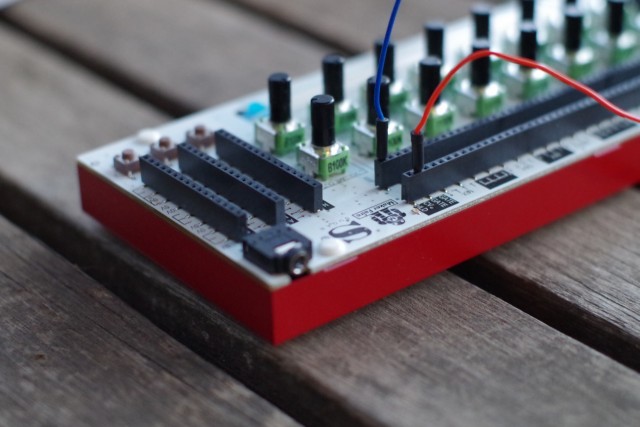
The Soundmachines NS1nanosynth is a miniature modular synthesizer that’s priced about the same as one module of a full-size modular synth.
It’s cheap, as modular synths go, because it dispenses with custom screen printed panels, jacks, knobs – leaving you with the essence of a modular: a circuit board.
Developer Davide Mancini describes the NS1nanosynth as ‘A powerful, deep and hacker-friendly blend of a real analog modular synthesizer and an Arduino platform’.
Can a modular analog synth that fits in your pocket be taken seriously?
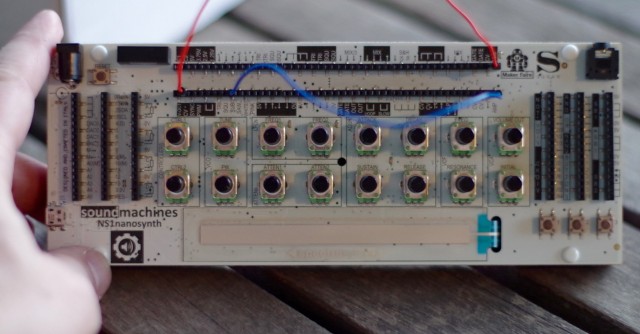
Design & Build
The NS1nanosynth is tiny – small enough to fit in your pocket, if you wear cargo shorts.
But designer Davide Mancini has packed a surprising number of capabilities into the NS1nanosynth.
On board the Soundmachines ‘nanomodular’ you’ll find:
- a saw core thermally stabilized v/oct VCO
- a 12db lowpass and bandpass VCF
- two LFOs
- one loopable ADSR envelope
- a standard VCA
- two adjustable attenuators; and
- more than a dozen “micro” modules, including mixers, multiples, sample and hold, sum/sub blocks, inverters, logic or, and, nand, analog dividers, clock dividers and fixed voltage generators.
That’s a lot of features, but the NS1nanosynth also includes an Arduino Leonardo microcomputer, USB connectivity, a ribbon controller and more.
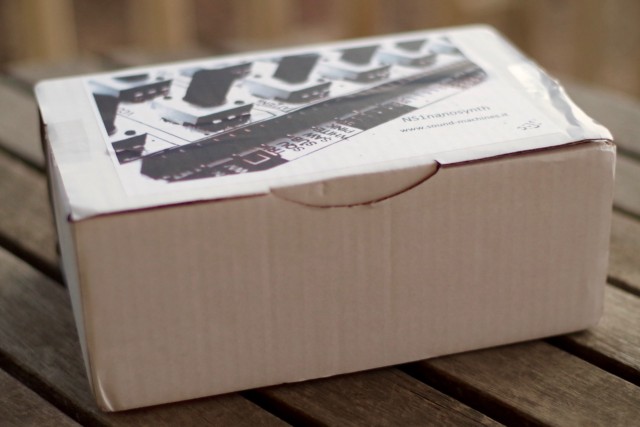
The box itself is pretty unassuming. Inside, this is what you’ll find:
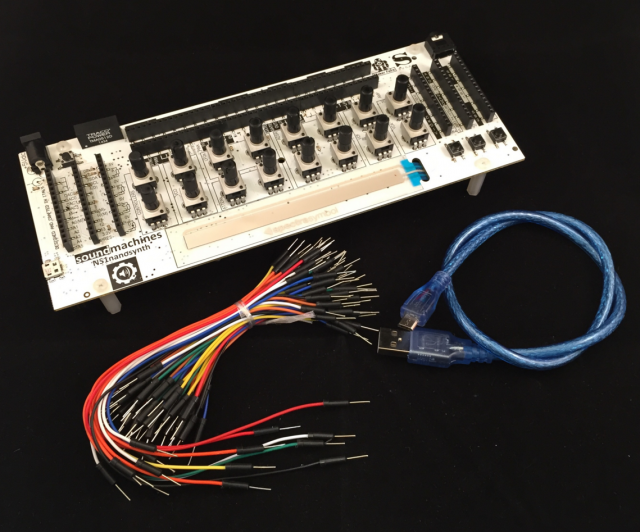
The NS1nanosynth comes with a large collection of breadboard-style patch cables and a USB cable. It’s designed to be powered by USB, but can also be powered by a 5VDC wall wart (not included).
All NS1nanosynth modulars now also come in a case, as shown at top, to minimize the possibility of damaging the circuits.
The NS1nanosynth is laid out with a left-to-right flow in mind:
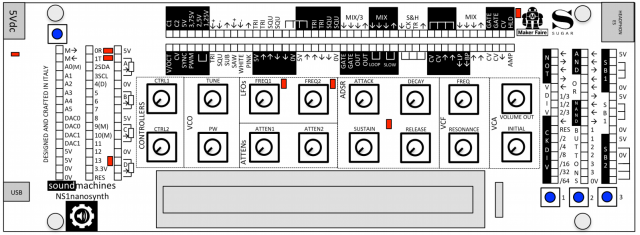
The left side of the NS1nanosynth exposes the connections for the Arduino Leonardo. The Arduino is a user-programmable microcontroller that comes loaded with USB MIDI-to-CV firmware. This means that controlling the NS1nanosynth from a computer or iPad is pretty plug-and-play. If you want to use the Arduino to do something else, though, thousands of applications are available for it and it’s a popular developer platform.
Pitch, modulation & gate CV’s are available via the Arduino headers and can be patched directly into the modular analog modular section, which is found in the middle of the nanomodular. Full connectivity is available for the Arduino, in addition to these CV’s, which means that programmers can create custom firmware to control the modular or support bidirectional connections with other devices.
Finally, the right side of the NS1nanosynth has logic functions (AND, OR, NOT, NAND), a clock divider, patchable button controllers, sensor expanders and an audio out.
Nanomodular Architecture
The NS1nanosynth has a capable synth architecture for a microsynth. It only offers a single VCO, VCA, VCF & envelope, but each of these offer more options than most budget analog synths.
For example, the oscillator offers V/Oct & CV control inputs, along with Sync and pulse-width modulation. On the output side, it offers square, triangle and saw wave outputs, along with a sub and white and pink noise.
The strength of the NS1nanosynth’s architecture, though, is in its connectivity and the range of modules that it offers:
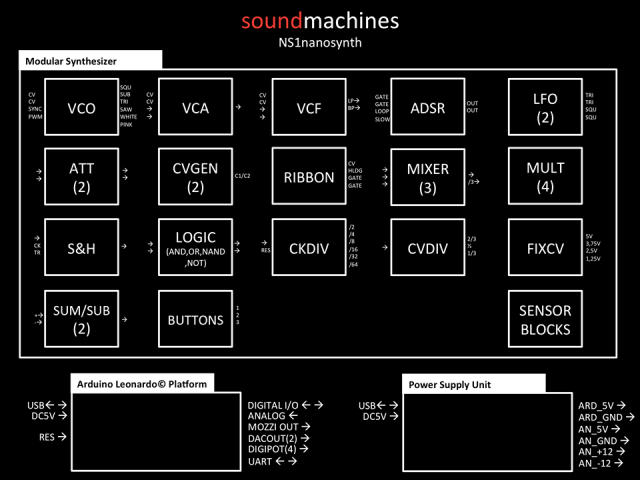
Functions that we’re surprised to see in a budget analog modular include: fixed CV voltage sources, three mixers, four mults, sample and hold, clock divider, math modules and the previously mentioned logic modules.
Using The NS1nanosynth
The NS1nanosynth synth section is completely modular. Plug it into your computer and all you’re going to get is blinkenlights. To get any sound, you have to explicitly patch any connections that you want.
Getting started with patching it is a little daunting at first, too, because there are well over 100 patch points on the tiny device. And, if you need glasses for reading, you’ll probably need them to be able to patch the NS1nanosynth, because the type is tiny and the patch points are a fraction of an inch apart.
Fortunately, the NS1nanosynth manual is excellent and provides multiple example patches, like this:
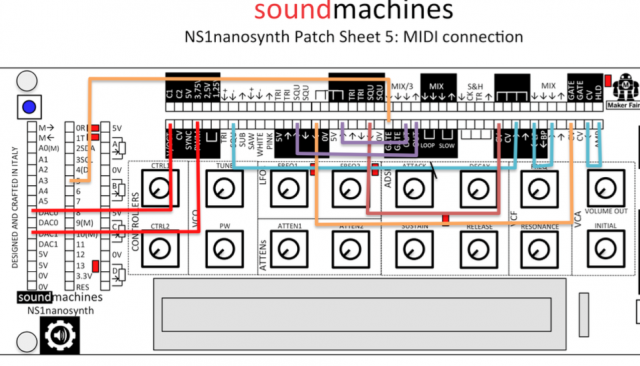
Once we tried the examples in the manual, the nanomodular made sense, and we started creating our own patches.
Here’s a short video example that features four NS1nanosynth patches:
The video documents our testing of several aspects of the synth:
- The first patch is a bassline sequence, sequenced by Nodal running on a MacBook Pro. This patch let us see how USB MIDI control worked (seamlessly) and also to check the stability and scaling of the NS1nanosynth oscillator. Tuning the oscillator is a little fiddly, because you’re working with a single tuning pot. But the oscillator played in scale. across multiple octaves. This patch has a short echo added to it.
- The second patch explores using the ribbon controller to control the oscillator’s pitch. Two tracks of this are used.
- The third and fourth patch try out typical old-school modular synth sounds, filtered white noise and sample and hold bleeps.
In addition to the manual, Soundmachines has shared a fairly extensive playlist of videos, embedded below, that demonstrate key features of the NS1nanosynth. If you’re interested in the NS1nanosynth, these offer demos of each of most of the key modules:
Here are some of our key takeaways from testing the NS1nanosynth:
- The NS1nanosynth is a capable little modular. The basic analog synth voice is simple (a single VCO-VCF-VCA-EG), but the Arduino and extensive collection of modules result in deep patchability and extendability.
- The NS1nanosynth offers many options that are unavailable on analog synths in the same general price range.
- The tradeoff for making it tiny and inexpensive is usability; breadboard-style patching is workable, but not as usable or fun as working with a full-size modular.
- The small potentiometers make fine control of patches a bit ‘fiddly’. The lack of finer controls makes it harder to tune the oscillator the way you want or to dial in the sweet spot you are looking for with the filter.
- The NS1nanosynth uses non-standard signals for modulars – 0-5v, which means that connecting it with other modular gear would require some special attention. Soundmachines does offer an optional NS1nanobridge expansion board that provides 14 minijack patch points for interfacing easily with other modular systems.
- A NS1nanosynth Experimenter’s kit is also available that’s designed for experimenting and expanding the NS1nanosynth with DIY electronics.
Summary:
The Soundmachines NS1nanosynth is a powerful little system that carves out new territory in the modular world.
The NS1nanosynth doesn’t really compete with full-size modular synths. Both Euro and 5U synths offer much better usability and a wealth of expansion options.
But the NS1nanosynth is cheaper by an order of magnitude. A Eurorack Ardcore module – comparable to just one of the NS1nanosynth’s modules – is more expensive than the entire NS1nanosynth modular.
Soundmachines tiny modular is an interesting solution for situations where an expensive full-size modular doesn’t make sense. It’s an inexpensive ‘modular synth lab’, and could be a great tool in education, where you could affordably put one in each student’s hands. It’s also a great platform for music hacking, with its combination of a full Arduino and a complete modular synth.
Pros:
- It’s a capable modular synth that’s tiny and affordable
- Wide variety of modules, including some less common ones
- Lots of patch points and connectivity options
- Great platform for experimentation, education and hardware music projects
Cons:
- Tiny controls and breadboard-style patching are fiddly
- Small pots make dialing in the sound you want trickier than on full-size modulars
- Simple single VCO-VCF-VCA-EG synth voice is limiting
The Soundmachines NS1nanosynth is available for 198,00€ at the SoundMachines site.
If you’ve tried the NS1nanosynth, leave a comment and let us know what you think of it!

I would not compare this to the Ardcore. This does not interface directly with modular and the support for Ardcore is very robust! Darwin has given sooo much with the Ardcore platform.
Darwin is awesome, but I’m not sure I understand your comment. It looks like this will interface with anything you patch it to.
Did you not see the MIDI connection patch sheet in the article or the video that shows the Arduino controlling the modular?
Maybe put this a different way. If there was a panel and jacks ‘upgrade’ I would be more interested. Charge what you have to for the upgrade kit, but this gains more momentum if you are eurorack ready. Real power is in ‘and’, not ‘or’. If I can have this ‘and’ my euro then it makes it more useful to experiment with than just a DIY nightmare of work to try and figure out how to get it into my rack. Let’s face it, most eurorack stuff boils down to test equipment so might as well use the standard as such, right?
There is a little kit for converting to 1/8th in jacks. I just use some cables I made with pin headers for ground and signal and an 1/8th in. mono connector. They work well and let me connect to whatever I need. Signals are all 0-5v except the audio output. Maybe less useful for most Eurorack, but is awesome for DIY and Arduino stuff.
Mr. DSC: I love that you know nothing about it and still rant, when a little research from your part would make you not stand out as a complete tool 😛
We shall see! I will check back in on this in a year and see how much traction this has made. I have made it my life’s work converting these types of gadgets over to the euro format and this looks like a pain in the ass to do so. You can check out my site if you think I am talking out my ass.
“You can check out my site if you think I am talking out my ass.”
Not if you don’t share a link!
Well, it has almost been a year and I have to say I am really glad this project is still around. However a quick look into the forum and it seems at least one person would really like a standard eurorack interface. And really I can’t blame him, but maybe if this project can find new legs, maybe he will get his wish.
the Adrcore is more reprogrammable eg .. sample playback , cv recorder , clock divider, it can emulate several euroracks like the turing machine and noise ring and with the expander you can do some crazy stuff like have a VCO with 8 outputs
the two can not be compared … but would work well together.
Why do you think an Ardcore is more programmable?
They both have the same ‘brain’, an Arduino.
#Hai
they don’t have the “same brain” Arduino Micro vs Arduino Uno
NS1nanosynth runs Mozzi – Adrcore does not
there are MANY sketches for the Ardcore so currently it is more (reprogrammable)
— NS1nanosynth has a few sketches …. it is patchable
they are very different the NS1nanosynth: is more “powerful”
but the Adrcore is a eurorack first
and the output expander is very useful
Ardcore is more established, but they’re both Arduinis and the Ardcore doesn’t offer half the connectivity of the NS1, even if you do add the expander module.
The Uno based Ardcore is fine and there’s nothing wrong with it, but the ATmega32u4 AVR chip on this one not only has more RAM than the Ardcore’s ATmega328, but it has separate hardware Serial outputs and a USB ports, which is dramatically more useful than having them be shared. Also, more pins can be run in PWM mode, which means more pins can work as 8 bit control outputs, and the I2C pins are separate from the GPIO pins, which means more outputs as well.
So… if someone actually knows what they are talking about, they know that the NS1nanosynth’s microcontroller is considerably more capable than the Ardcore. However, devices using ARM chips are often even better still, though right now it’s mostly roll your own for modular format, but no big deal for those of us who are capable.
============================================================
#RabidBat #Herchara i am sure you both don’t have a Adrcore
// —————————————–
both units are not comparable
the Ardcore is a eurorack
the NS1nanosynth is more powerful
they would work really well together
// —————————————–
the Ardcore has more sketches, more support
so , you misunderstand my meaning of “more reprogrammable ”
i was talking about” community support”
i am sure these sketches can be recompiled for the NS1nanosynth
===================== end of program =======================
i wonder if you could by two of these and chain it to have two EG’s and two sets of lfo’s etc?
Wouldnt it be great if it had a chain option and you could send each or both osc and have the fiters in serial…
If there is a way to do this, and sum the ouput effectively, i would buy in 3 seconds
There are a bunch of multiples on the board so this would be pretty simple
http://www.sound-machines.it/product/ns1nanobridge/
Theres a bridge for all the euro guys 🙂
Here is a randomly generated gate sequencer I made for the NS1. It has clock input and also you can change the length. I’m going to add a CV sequencer using the digipots on board. Having the two separate sequencers running at different lengths will make it very interesting. So many ways to patch and get constantly evolving sequences.
https://github.com/KyleWerle/NS1Nanosynth/blob/master/NS1-RandomSeq.ino
Video demo?
#wo3
and here is a Dual Euclidean sketch for the Ardcore
An implementation of a dual trigger sequencer using Euclidian Rhythm concepts
https://github.com/darwingrosse/ArdCore-Code/blob/master/20%20Objects/AC30_DualEuclidean/AC30_DualEuclidean.ino
They just announced to Show the Ns1 mini in Berlin at superbooth. Hope to see this to my Ns1 to get even more of nearly everything. But two vco alone would take it to a new level…
honestly, this article is more a copy of the manual than a review …
my NS1 has mostly been collecting dust. i was hoping for an affordable tinysizer but with just one VCO and LPF it’s not as “deep” as advertised … granted it has all these extra utilities, but – to exaggerate a bit – why do i need a mixer if there is only one sound source, or multiple, if there is nothing to send the outputs to?
also, i don’t dig the advertising with digital effects when no examples are provided.
i’m still giving it a chance and not selling rn, maybe people will come up with cool patches i haven’t thought of. but i probably wouldn’t buy again. for practical purposes, afaics its only about as versatile as the Korg littlebits, which are cheaper and more fun.
It’s deep enough alright.
But you have to use the Arduino as a DCO for a hybrid synth and not the VCO.
It sounds like you don’t understand either the nanosynth or synthesizers in general.
In modulars, it’s really handy to have extra mixers and mults. For example, you can mix cv’s together before modulating other modules. Obviously, you can use them to mix oscillator outputs to create complex waveforms. What if you want to use multiple filter outputs at the same time and control levels?
And there’s a lot more than one sound source.
There are 5 on the oscillator, another 4, I think, on the LFOs, which can go into the audio range, 2 noise sources, audio out on the Arduino, the sample and hold out, which could be used to do bitrate reduction, etc.
With that many audio sources, multiple mixers are handy.
i’m aware the one VCO has multiple outputs – all going at the same frequency. which multiple filter outputs do you speak of? it sounds you are not familiar with the facilities available on the NS1.
also, yeah, like i say, you – could – program the arduino with anything you wanted. you can do that however with any arduino and the NS1 does not help you with that in any way.
i’d be happy to be proven wrong and await your examples.
It’s got LP & BP. You should seriously RTFM, before you suggest that somebody else doesn’t know what this can do
There are at least a dozen audio sources that you could mix together on this thing. You can do FM, PWM, oscillator sync – a lot of stuff for something so cheap and tiny.
I can understand if you don’t get into this synth – it’s so tiny – but don’t imagine it’s not capable for its size.
It’s harder to get into the features of this synth, because of its tiny size, but that’s a trade off for it being so portable.
The Roland SH-101 is a single OSC, single LFO, single ENV instrument. People seem to get on with it pretty well. 😉 It uses a three channel mixer to mix the different waveforms the single OSC outputs (just like the NS1).
Of course, how those things sound together ‘make’ the synth. Maybe this one just doesn’t speak to you but it’s probably not from lack of synthesis features.
it’s true, compared to an SH-101 the NS1 has more facilities. no sequencer, but hey, you can run one on the arduino i’m sure. also no human sized sliders, but hey, i’m sure you can cook up something using the analog i/o pins on the arduino. also the sound is completely different for example less organic, and of course, less iconic (hard to blame the NS1 for the latter).
so, if you have an SH-101 you want to trade for my NS1 – i’m down, anytime 😉
Both the NS1 and Ardcore look pretty cool to me.